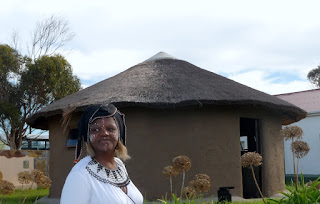It is also known for livestock on the
road! I’m told that this harkens back
to a time when all animals were communally owned, so there was no need for
fences. Today, the animals are
privately owned (based on the spray-painted markings on their flanks), but
there are still very few fences.
You’ll see shepherd boys beside a small herd, but you’ll
also see goats, sheep, cattle, ducks, geese, and a random pig on their own, eating
beside the road or standing in the middle of it! Unconcerned with cars, they often do not
move, and the traffic simply slows and goes around them.
Jim
and I saw many traditional round rondeval homes. They are rarely
seen in PE (except in paintings). Most here were no longer made of mud and sticks, but rather out of cement and painted various pastels. About half had thatched roofs; the other half tin. Most of the housing appeared newer than 15 years old. Jim surmised that because this was Mandela’s home area, it may have been one of the first benefitted during
his presidency.
 |
| Face make-up |
 |
| Traditional long-stemmed pipe |
Today, while most children, teenagers and men wear typical “western” attire, most women still wear
longer skirts, often in colorful calicos, or in white cloth with black horizontal embroideries.
Bags in matching colors with long shoulder straps are popular. Most women cover their heads with
scarves intricately tied.
Last, they often wear “make-up” which can consist of white or ochre colors on their faces. When our students had their faces painted, they came back and said, "You won't believe what they used for the make-up. It was calamine lotion!" (I thought to myself - that must not be traditional. But, I bet it was no more than ten minutes later, I picked up a novel I was reading where it talked about young women putting on their calamine make-up! I just laughed.)
Last, they often wear “make-up” which can consist of white or ochre colors on their faces. When our students had their faces painted, they came back and said, "You won't believe what they used for the make-up. It was calamine lotion!" (I thought to myself - that must not be traditional. But, I bet it was no more than ten minutes later, I picked up a novel I was reading where it talked about young women putting on their calamine make-up! I just laughed.)


You went without us! Glad you enjoyed and even more reason to go back. :-)
ReplyDeleteWish you could have been along!
Delete